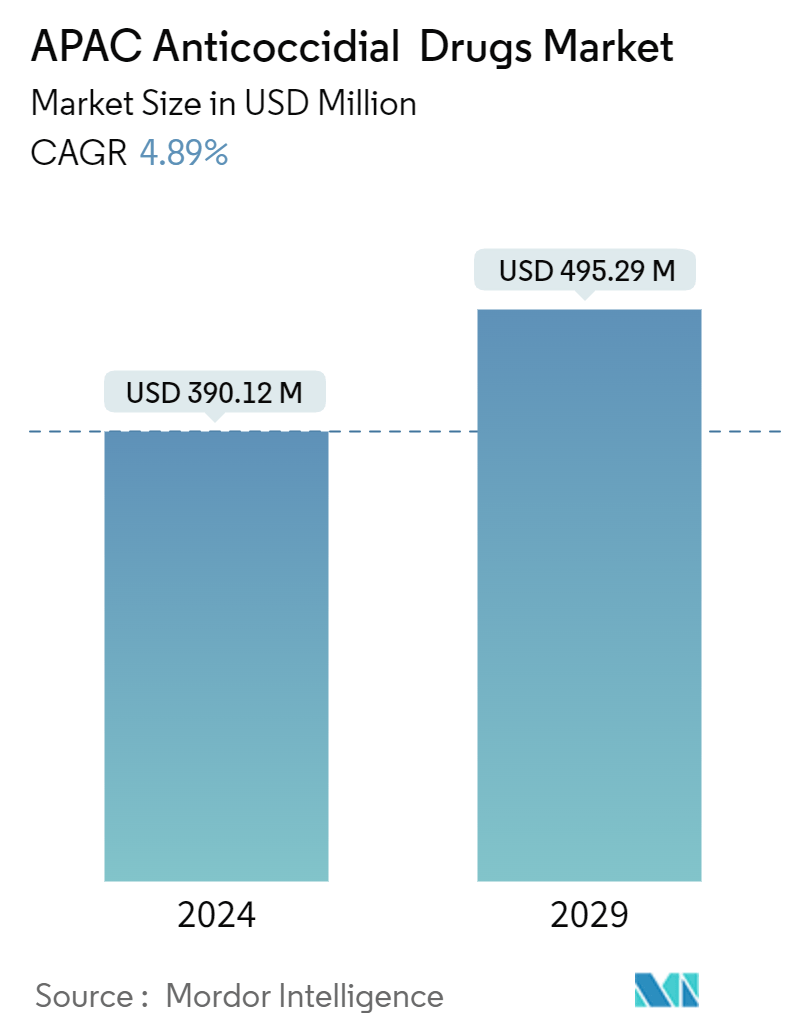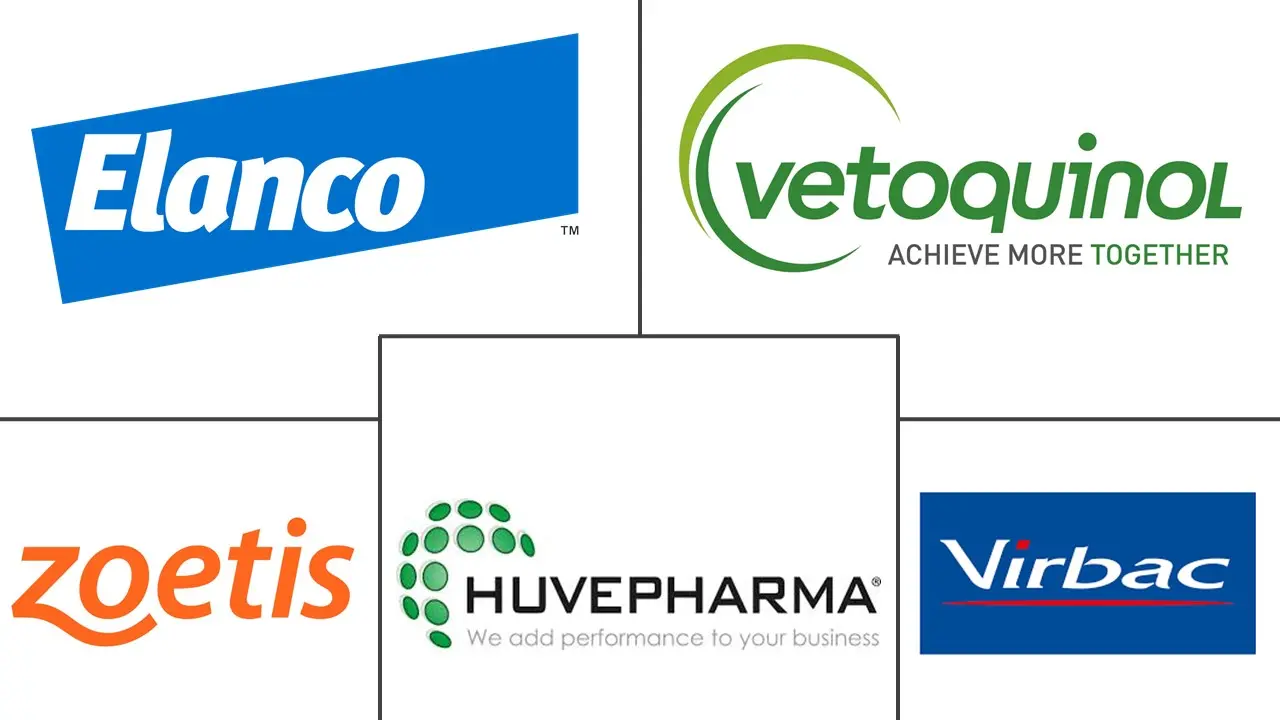Market Size of APAC Anticoccidial Drugs Industry

| Study Period | 2019 - 2029 |
| Base Year For Estimation | 2023 |
| Forecast Data Period | 2024 - 2029 |
| Market Size (2024) | USD 390.12 Million |
| Market Size (2029) | USD 495.29 Million |
| CAGR (2024 - 2029) | 4.89 % |
Major Players
*Disclaimer: Major Players sorted in no particular order |
Asia-Pacific Anticoccidial Drugs Market Analysis
The APAC Anticoccidial Drugs Market size is estimated at USD 390.12 million in 2024, and is expected to reach USD 495.29 million by 2029, growing at a CAGR of 4.89% during the forecast period (2024-2029).
The APAC Anticoccidial Drugs Market size is estimated at USD 390.12 million in 2024, and is expected to reach USD 495.29 million by 2029, growing at a CAGR of 4.89% during the forecast period (2024-2029).
Due to the COVID-19 outbreak, a short-term negative impact was seen on the market due to decreased visits to veterinary hospitals and clinics. Healthcare services were significantly reduced due to social distancing measures taken by governments across the globe. For instance, as per the data published by the National Institute of Health in March 2021, it was observed that pet adoption increased in Asian countries during the pandemic, and initial vaccinations on pets were done regularly. However, other than pets, the farm animal vaccination was not done at a given time due to the pandemic restrictions. Additionally, standard practices such as routine animal checkups, diagnoses, and surgeries were disrupted. These decreased services lowered the coccidiosis diagnosis. But, at the later stage of the pandemic, smart agriculture and livestock production systems with animal welfare aspects were adopted. For instance, according to an article published by Frontiers in Veterinary Science in January 2021, initiatives such as a national risk assessment, clear communication channels, contingency plans, a crisis response group, and support systems for animal care providers were taken by Australia for animal welfare. This initiative during the pandemic led to increased demand for diagnosing animal diseases, and market started to witnessed gradual growth.
Factors such as increasing incidence of coccidiosis and advancements in veterinary healthcare are expected to drive market growth over the forecast period. For instance, according to an article published by Veterinaria Digital S.A., in December 2021, humidity and temperature conditions in Southeast Asia are two critical factors for the development and survival of coccidia and its vector, the Alphitobius beetle. All of them promote high infectious pressure in indigenous chicken breeds. According to the above source, a prevalence of 65.83% and 68.5% of coccidia, respectively, was observed in Ben Tre and Hau Giang provinces. Such a high incidence of coccidiosis in the region is expected to increase the demand for anticoccidial drugs, thereby driving the market growth.
Moreover, Eimeria is a genus of apicomplexan parasites that includes various species capable of causing the disease coccidiosis in animals such as cattle, poultry, dogs, cats, and smaller ruminants, including sheep and goats. According to the research article published in August 2022, in Queensland, Australia, weaned cattle tend to be more affected in summer due to coccidiosis, possibly because of stress, and even if it can happen to a year-old cattle, clinical infection usually starts at 1-2 months of age because coccidiosis rarely manifests in the first three weeks of life. Thus, the burden of coccidiosis among the target animals of specific age demands the availability of the effective treatment which is expected to boosts the market growth over the forecast period.
However, the availability of alternative treatment options in the market is expected to hinder market growth over the forecast period.
Asia-Pacific Anticoccidial Drugs Industry Segmentation
As per the report's scope, coccidiosis is one of the most frequent and prevalent parasitic diseases among domesticated animals. Its symptoms include weight loss, mild intermittent to severe diarrhea, feces containing mucus or blood, dehydration, and decreased breeding. Any drug used to combat the progression of coccidiosis in birds or animals, both food-producing and non-food-producing, is termed an anticoccidial.
The Asia-Pacific Anticoccidial Drugs Market is Segmented By Drug Type (Ionophore, Antibiotic, Sulphonamides, Chemical Derivative, and Others), Drug Action (Coccidiostatic and Coccidiocidal), Animal (Livestock Animals and Companion Animals ), Distribution Channel (Veterinary Hospitals, Retail Pharmacy, and Others), and Geography (China, Japan, India, Australia, South Korea, and Rest of Asia-Pacific). The report offers the value (in USD) for the above segments.
| By Drug Class | |
| Ionophore | |
| Antibiotic | |
| Sulphonamides | |
| Chemical Derivative | |
| Other Drug Classes |
| By Drug Action | |
| Coccidiostatic | |
| Coccidiocidal |
| By Animal | |||||
| |||||
|
| By Distribution Channel | |
| Veterinary Hospitals | |
| Retail Pharmacy | |
| Other Distribution Channels |
| By Country | |
| China | |
| Japan | |
| India | |
| Australia | |
| South Korea | |
| Rest of Asia-Pacific |
APAC Anticoccidial Drugs Market Size Summary
The Asia-Pacific anticoccidial drugs market is poised for significant growth over the forecast period, driven by an increasing incidence of coccidiosis and advancements in veterinary healthcare. The market experienced a temporary setback due to the COVID-19 pandemic, which disrupted routine veterinary services and vaccinations for farm animals. However, the adoption of smart agriculture and livestock production systems, along with initiatives for animal welfare, helped the market recover. The high prevalence of coccidiosis, particularly in Southeast Asia, is expected to boost demand for anticoccidial drugs. Factors such as humidity and temperature conditions in the region contribute to the high infectious pressure, further driving market growth. The burden of coccidiosis among various animals, including cattle and poultry, necessitates effective treatment options, which are anticipated to enhance market expansion.
In South Korea, the market growth is supported by a rising animal population and increased expenditure on pet care. Initiatives like research surveys and diagnostics to promote pet health, along with the establishment of national animal health insurance programs, are expected to further drive demand for anticoccidial drugs. The competitive landscape of the market is moderately concentrated, with both global and regional companies like Boehringer Ingelheim, Elanco Animal Health, and Zoetis Animal Healthcare playing significant roles. Recent developments, such as joint ventures and product launches, indicate a proactive approach to addressing animal health challenges in the region. Overall, the Asia-Pacific anticoccidial drugs market is set to witness substantial growth, supported by both demand-side factors and strategic industry developments.
APAC Anticoccidial Drugs Market Size - Table of Contents
-
1. MARKET DYNAMICS
-
1.1 Market Overview
-
1.2 Market Drivers
-
1.2.1 Increasing Incidence of Coccidiosis
-
1.2.2 Advancements in Veterinary Healthcare
-
-
1.3 Market Restraints
-
1.3.1 Availability of Alternative Treatment Options in the Market
-
-
1.4 Porter's Five Force Analysis
-
1.4.1 Threat of New Entrants
-
1.4.2 Bargaining Power of Buyers/Consumers
-
1.4.3 Bargaining Power of Suppliers
-
1.4.4 Threat of Substitute Products
-
1.4.5 Intensity of Competitive Rivalry
-
-
-
2. MARKET SEGMENTATION (Market Size by Value - USD million)
-
2.1 By Drug Class
-
2.1.1 Ionophore
-
2.1.2 Antibiotic
-
2.1.3 Sulphonamides
-
2.1.4 Chemical Derivative
-
2.1.5 Other Drug Classes
-
-
2.2 By Drug Action
-
2.2.1 Coccidiostatic
-
2.2.2 Coccidiocidal
-
-
2.3 By Animal
-
2.3.1 Livestock Animals
-
2.3.1.1 Cattle
-
2.3.1.2 Poultry
-
2.3.1.3 Other Livestock Animals
-
-
2.3.2 Companion Animals
-
2.3.2.1 Dogs
-
2.3.2.2 Cats
-
2.3.2.3 Other Companion Animals
-
-
-
2.4 By Distribution Channel
-
2.4.1 Veterinary Hospitals
-
2.4.2 Retail Pharmacy
-
2.4.3 Other Distribution Channels
-
-
2.5 By Country
-
2.5.1 China
-
2.5.2 Japan
-
2.5.3 India
-
2.5.4 Australia
-
2.5.5 South Korea
-
2.5.6 Rest of Asia-Pacific
-
-
APAC Anticoccidial Drugs Market Size FAQs
How big is the APAC Anticoccidial Drugs Market?
The APAC Anticoccidial Drugs Market size is expected to reach USD 390.12 million in 2024 and grow at a CAGR of 4.89% to reach USD 495.29 million by 2029.
What is the current APAC Anticoccidial Drugs Market size?
In 2024, the APAC Anticoccidial Drugs Market size is expected to reach USD 390.12 million.

